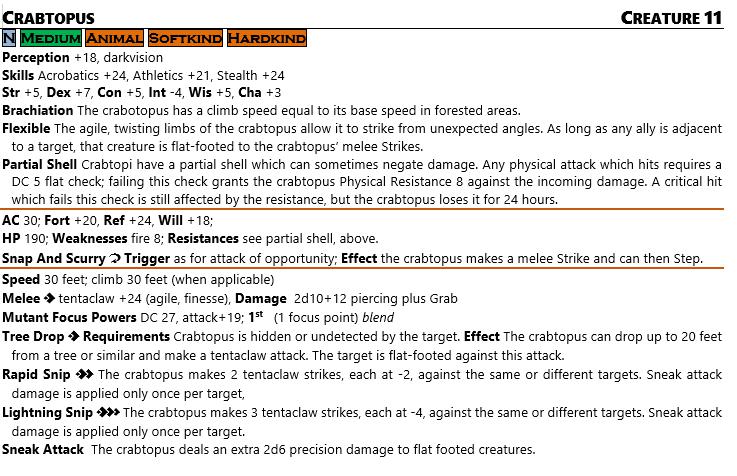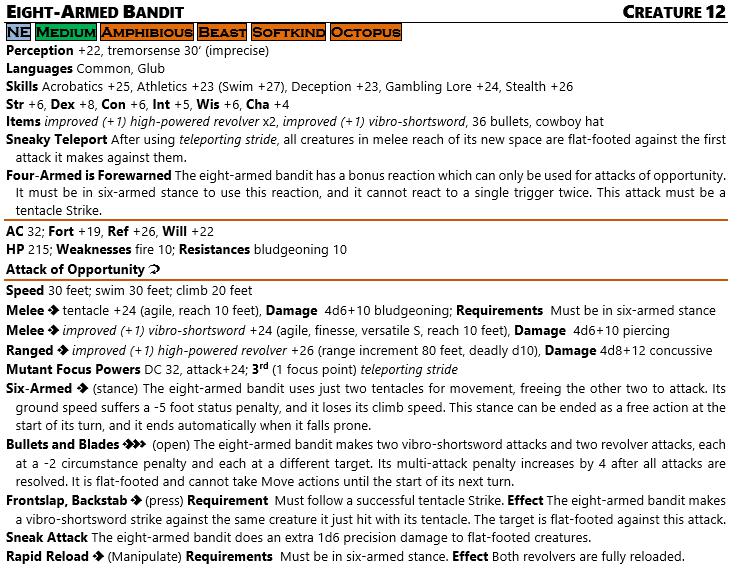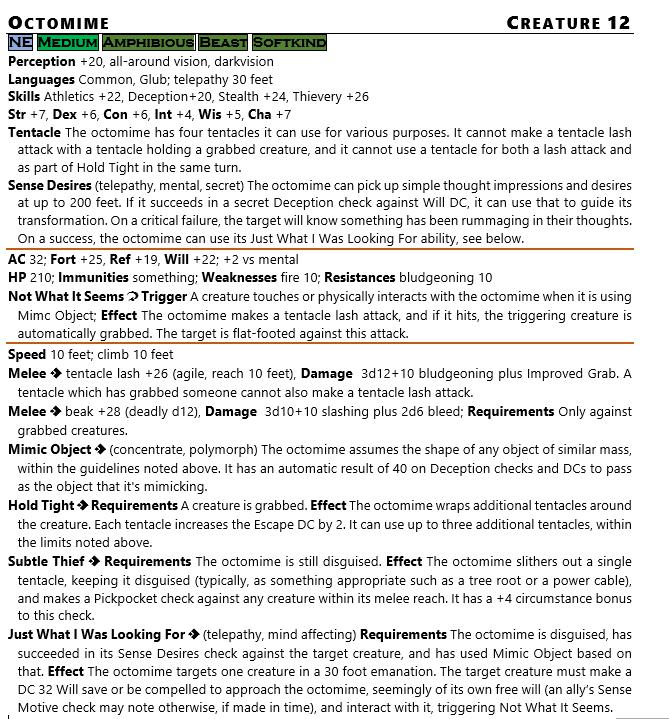Some Earth Delta Stuff
Earth Delta Updates
I Was Going To Walkthrough/Review “Sir Pellinore’s Favorite Game”, But Time Was Not On My Side
Meaning, I Finally Installed Baldur’s Gate 3 And Wasted An Afternoon
But I Did Get Three More Monsters Done This Weekend, So, Here.
OK, as it was Octopus Day earlier this week, I jotted down some ideas for octopus-inspired creatures, and actually managed to design three of them. All of these are in very rough shape, literally just finished the first drafts, and in need of typos and rebalancing. I mean, in need of fixing typos.
To add some content here, I’ll include some design notes/thoughts as well.
Crabtopus
This was partially inspired by my wife — no, not like that! — she was the one who told me it was World Octopus Day, and we discussed some ideas, which eventually merged into this, among others. As I started statting it, I had in mind the “brute” roadmap – Low AC, high hit points, very straightforward – but as I started adding in abilities, it kept drifting to a skirmisher type – many attacks with slightly lower base damage, amplified by sneak attack and ways to make enemies flat-footed to accomplish this. I almost removed the partial shell feature entirely, as that’s more a “brute” thing, but there’s no need for absolute design purity.
“What do you get when you cross a crab with an octopus?”
“Your funding cut and a visit from the ethics committee!”
(A koan of the Ancestors, still being studied by the scholars of New Dawn)
The crabtopus is a common predator in forested areas with many lakes and streams. It will eat almost anything that doesn’t eat it first, and while they are not truly social or pack creatures, they will cooperate to bring down larger prey if there are several of them in the area, as often happens during mating season. As this time also causes them to burn energy rapidly, it can lead to more attacks on creatures that would otherwise be left alone. (The appearance of a kliksquish, a herd of mating crabtopi, around a lake safehold’s primary source of food and water, can lead to calls for bold heroes to sally forth and do what they do best – kill things for money.)
In general appearance, the crabtopus is a human-sized octopus, with tough, leathery skin, well adapted to land life. Each of its tentacles end with crab-like pincers, and it has a tough carapace over parts of its head and back. They are colored to blend in with the surrounding forest, and chromatophores adapt to changing seasons.
Eight-Armed Bandit
This, like a lot of what I create, was inspired by a random image that walked into my head – possibly one I’d seen before, but forgot the source of. In this case, an octopus-like creature with a cowboy hat, two six-shooters, and a sheriff’s badge, against a typical desert setting. It lost the badge, kept the hat and guns, and moved to the swamp. The teleporting stride was kind of a whim, to make it unique in that random Gamma World way, where “it’s a mutant plant with electrical generation, radiated eyes, and attraction odor” is a pretty typical thing to encounter. This one also ended up being skirmisher-ish, so it needed some good mobility. Another aspect of several of the octopi is to give them melee reach their size does not naturally provide – it’s a PF2 design principle to decouple game mechanics from physical form, e.g., size doesn’t automatically grant Strength bonuses and AC penalties, you can build those in if you want. And since arms with a 10′ reach aren’t notably unbalanced (any human can carry a spear or a pike, after all!), I didn’t think much of it. The “rapid reload” was just a fun idea, imagining the visual of it shaking out spent casings, pulling out fresh bullets, and loading the guns with its limbs coordinating all the necessary actions.
Legends of Lost Wages tell of the great gangs of one-armed bandits who looted and plundered throughout the land. Perhaps inspired by them, this mutant, land-dwelling octopus has become a virtual gang all by itself, though it prefers swamps and rain forests to desert wastelands. Roughly man-sized, it walks on either two or four of its limbs, and easily overwhelms foes with bullets, blades, and bludgeoning. Its innate ability to teleport, an individual mutation, gives it a tactical edge if overwhelmed. (Another individual of this type may have different mutations – as noted, bandits tend to be unique.)
Octomime
I considered “tentacle trap” and then “tentakiller”. I like that last one, but thought I should save it for something with a higher CR. This could have been easily done as a slightly-reskinned mimic, which is basically how I started, but I wanted to make it a little more unique. The “sneaky thief” aspect adds, to my mind, an unexpected aspect to an encounter, and I liked the idea of it having the ability (with a few good rolls) to override typical player caution in a way that makes sense in-universe. I picture the beak as being poorly positioned for use as a natural weapon normally, which in turn fed into (pun intended) the need to make it good at grappling, at the cost of some attack power – a tactical decision it can make turn-to-turn.
The ability of some cephalopods to change their color, shape, and texture to elude predators long fascinated pre-Cataclysm humans. It is possible the octomime began its existence in a bioweapons facility, as a living trap that could be placed outside of water, and which later developed sapience and increased size. It may also have been entirely a product of the Cataclysm’s life-warping energies. In its ‘natural’ form, it resembles a typical large octopus, with smooth, dull grey skin. However, it is rarely seen in that state unless dead. Its flexible body and wide array of pigment cells, combined with its ability to alter its texture in very fine increments, makes it capable of assuming almost any shape of similar mass (hollow or thin objects may be larger than medium size, up to what the GM feels is reasonable) and it has some limited telepathy that allows it to become something of value to a nearby creature. While it must remain entirely contiguous, it can look like a pile or barter items or a desk covered with laboratory gear, as well as a metal door, a rusting robot, a shelter dome, and darn near anything else.
It has no ability to imitate the hardness or resistances of what it is disguised as; if it imitates a titanium vault door, any attack will show that is not. Regardless of its shifted size, once it reveals itself, it will compress down to a standard five-foot space.
While it often appears as something desired by nearby creatures, so that they will touch it and hopefully become food, it can also choose to appear as valueless rubbish or vermin-infested remains. It will do this in order to let it steal valuables from unaware passers-by, sometimes to disarm them before it strikes, or sometimes to use in trade with other dwellers in the wastelands. Not a few explorers have made camp in a room with nothing of note but some rusing pipes along one wall, only to awaken with their weapons and tech items gone, and the wall somehow pipe-free.
And There We Have It
It’s not what I’d planned for this day’s entry, but hell, it’s an entry. Baby steps.




Comments
Some Earth Delta Stuff — No Comments
HTML tags allowed in your comment: <a href="" title=""> <abbr title=""> <acronym title=""> <b> <blockquote cite=""> <cite> <code> <del datetime=""> <em> <i> <q cite=""> <s> <strike> <strong>